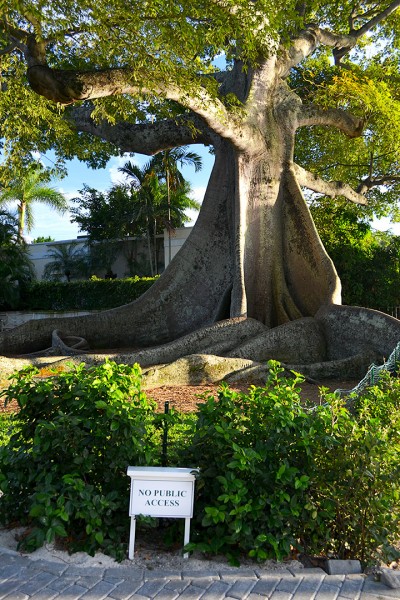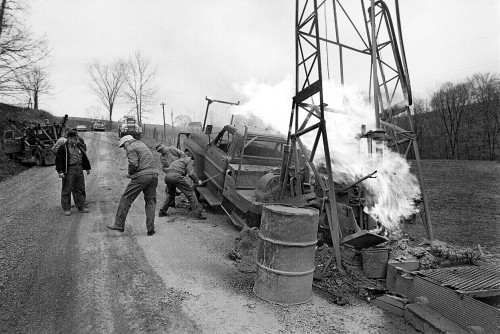 Road Warriorette Anne is back in Florida for a few weeks fleeing cold weather in Texas. For the record, that is NOT Anne. She took time off from her travel schedule to swim with manatees in Kings Bay in the Crystal River on Florida’s Gulf Coast. She bought a video of her experience, and I pulled a few frames out for this post.
Road Warriorette Anne is back in Florida for a few weeks fleeing cold weather in Texas. For the record, that is NOT Anne. She took time off from her travel schedule to swim with manatees in Kings Bay in the Crystal River on Florida’s Gulf Coast. She bought a video of her experience, and I pulled a few frames out for this post.
Here is her account:
I’m not crazy about the cold
 The night before my manatee swimming experience, I was actually pretty stressed out. I was excited, certainly. But the forecast was for 36 degrees at 7:15 a.m., which was the time we were due to arrive at the boat dock for our short ride to Kings Bay, where all the manatees were lounging in the relatively warm waters of Crystal River.
The night before my manatee swimming experience, I was actually pretty stressed out. I was excited, certainly. But the forecast was for 36 degrees at 7:15 a.m., which was the time we were due to arrive at the boat dock for our short ride to Kings Bay, where all the manatees were lounging in the relatively warm waters of Crystal River.
I am not a person who enjoys cold weather. Scratch that. I am a person who despises cold weather. But I had decided earlier in the day that if I was indeed going to honor my reservation, made before this rare arctic front swooped into west central Florida, I was going to do it cheerfully and have fun. A stop at the Goodwill store in Perry, complete with purchase of a cheap coat and blanket to keep me warm on the boat ride out and back, sealed the deal.
But the alarm was set for 5:45 (leaving time to eat breakfast before the boat ride), and I am ALSO not an early morning riser, so that was additional cause for anxiety. 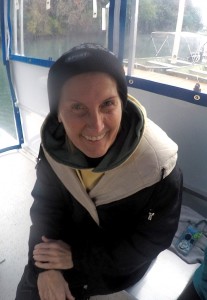 Not to mention I had driven 540 miles that day (and 525 miles the day before that), so I had a bit of white line fever running through my veins, I admit.
Not to mention I had driven 540 miles that day (and 525 miles the day before that), so I had a bit of white line fever running through my veins, I admit.
But I digress! It’s all about the manatees. Once I saw my first manatee in the waters of Kings Bay that morning, everything else slipped away. In my experience, it’s such a transporting experience to have a close encounter with another species, especially in their own habitat. [Editor’s note: that’s why she visits me.]
Although there were large areas of water cordoned off with buoys where visitors can’t enter, the manatees very often leave these sanctuary areas and come “visit” you! They are curious and just come right up to humans again and again.
My coat and blanket kept me warm on the boat ride out, and since it was such a cold day, maybe just 14 to 16 guests were in the whole area. Our guide told us the previous week (the holiday season) there were as many as 200 people in the water at one time. Which meant anytime a manatee was spotted, it was positively swarmed by humans, all with grasping hands and cameras, etc. I was definitely feeling there was an upside to the cold weather by this time.
Watch the video
The manatees’ whiskers were softer than I thought they’d be, but their skin is quite tough. Their wrinkles feel funny and it’s darling the way they almost always turn over to have their tummies scratched. I had two wonderful encounters; one was on camera, which you can see on the video, and one all alone, when I got nose to nose with a cow who came up for a close look. Then she turned over for me to pet her tummy, which I did; but then she slowly began twirling around and around, mesmerizing me so that I just kept my hand on her while she quietly rotated.
Violated the two-hand rule
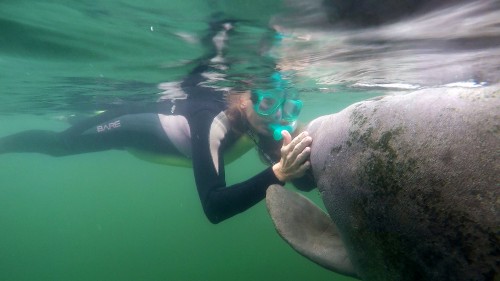 Our guide happened to be filming when I had my second special encounter. A cow came up to me very close and then actually reached toward me with both fins. It was the dearest thing. Something within me wanted to respond in kind, so I reached out with both hands to sort of cup her face or perhaps touch her fins, I’m not sure which. I wasn’t really thinking, just reacting to her gesture. But apparently there’s a “one-hand” rule, which I didn’t recall hearing, despite closely watching the video about procedures before departure. Whatever, I did actually get to touch her with both hands before I got caught and it was very meaningful to me (and maybe to her because she reached out first!) so I don’t care about getting caught!
Our guide happened to be filming when I had my second special encounter. A cow came up to me very close and then actually reached toward me with both fins. It was the dearest thing. Something within me wanted to respond in kind, so I reached out with both hands to sort of cup her face or perhaps touch her fins, I’m not sure which. I wasn’t really thinking, just reacting to her gesture. But apparently there’s a “one-hand” rule, which I didn’t recall hearing, despite closely watching the video about procedures before departure. Whatever, I did actually get to touch her with both hands before I got caught and it was very meaningful to me (and maybe to her because she reached out first!) so I don’t care about getting caught!
Two hours with the gentle giants
 Our small group of six that left from The Plantation Dive Shop stayed in Kings Bay for close to two hours, having multiple encounters with the gentle giants. The only time I was truly, bitterly cold was when we got out of the water. Then we were all actually shaking so hard that we spilled lots of hot chocolate as we tried to drink it to warm up.
Our small group of six that left from The Plantation Dive Shop stayed in Kings Bay for close to two hours, having multiple encounters with the gentle giants. The only time I was truly, bitterly cold was when we got out of the water. Then we were all actually shaking so hard that we spilled lots of hot chocolate as we tried to drink it to warm up.
But every one of us agreed it was totally worth it.
Swimming with manatees has been on my bucket list for quite a while. If it’s on yours, go do it, and don’t be afraid to pick a cold day.
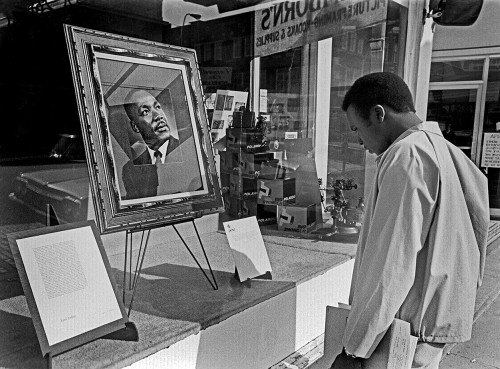 I photographed this young man looking at a portrait of Dr. Martin Luther King, Jr., in the display window of Lamborn’s Studio in Athens, Ohio, on April 9, 1968, five days after the Civil Rights leader was gunned down in Memphis.
I photographed this young man looking at a portrait of Dr. Martin Luther King, Jr., in the display window of Lamborn’s Studio in Athens, Ohio, on April 9, 1968, five days after the Civil Rights leader was gunned down in Memphis.
